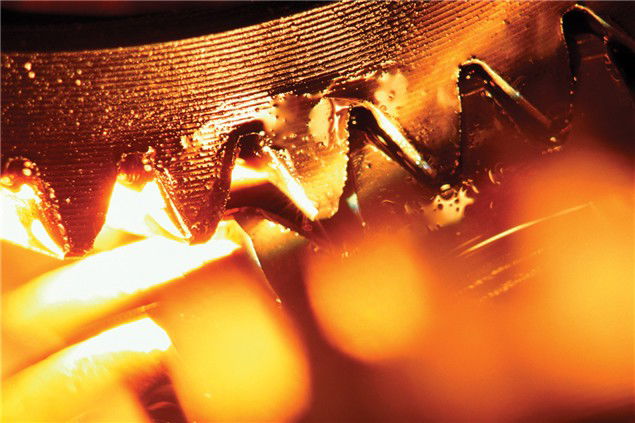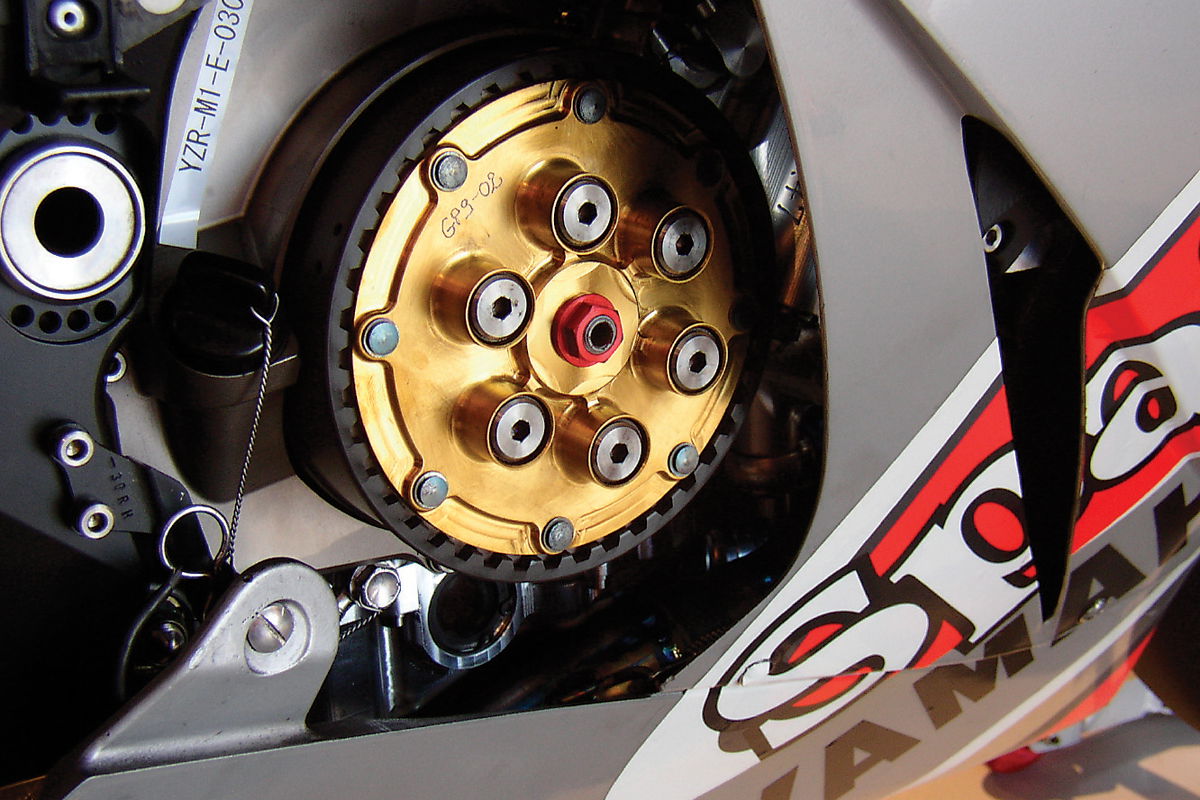Understanding Oil
Oil. Boring? Probably. Important? As vital to a motorcycle as blood is to our bodies. So if you want to make an informed decision on which oil is best for your bike (and pocket) then read on...


Debates often rage over which oil to use and whether you get your money's worth with expensive stuff. What's a synthetic oil anyway compared to a semi or mineral? Won't any old automotive oil do? Can you really improve the performance of your bike by using a top-notch quality oil? Well, here's how it all works...
If you've got a modern four-stroke motorcycle it'll use a re-circulating oil system (see tech drawing). An engine-driven pump draws oil from the sump through an oil strainer then pumps it through the oil filter and under pressure into oil galleries to the areas of main stress in the engine - ie the frictional and moving parts like cylinder walls, pistons, connecting rods and valves. A second, lower pressure feed circulates the oil to the top of the engine where it lubricates the valve train components before draining back down to the sump. While cars use separate lubricants for the engine, starter motor, clutch and gearbox, everything is compact on a motorcycle so they're integrated onto the same crankshaft and lubricated by the same oil - a crucial difference as motorcycle oils need to withstand shearing from the meshing of gears that breaks down the molecules, causing the oil to thin and fall out of grade. It also needs to provide enough friction for the starter motor to engage and to prevent clutch slip. A two-stroke is a different kettle of fish altogether as it runs a total loss engine oil system with the engine oil being part of the combustion so a separate oil for the gearbox is also used.
There is a variation in a re-circulation system in the form of a wet or dry sump. A dry sump uses a separate container to store oil while the wet sump drains oil back into an extension of the crankcase. Wet sumps are more common because, although the engine often needs to be taller to accommodate a wet sump, you don't need to find space for an oil tank or bother with a return system as the oil drains back down to the sump. Harleys and off-road style bikes use dry sumps, the latter storing oil in the frame.
Engine oil comes from the Earth, indeed from the same source as petrol. Mineral oils are derived by fractional distillation from crude oil and can withstand higher temperatures and are less prone to oxidation (breakdown of the molecules, hence breakdown in viscosity) compared to animal and vegetable oils, which makes them better suited to engine conditions.
On the other hand synthetic oils are man modified: they're chemically manufactured to have the perfect mix of properties to suit an engine, with a linear molecular structure (ie doing away with the smaller molecules called 'light ends' that evaporate with heat leaving the larger molecules or 'heavy ends' behind, which causes both oil consumption and thickening of the oil). This results in superior lubricating characteristics such as higher resistance to heat and contaminants. They're also more expensive to produce hence the higher price tag, but they're more durable.
Then, semi-synthetic oils are a blend of mineral and synthetic bases that provides a good compromise between price and performance.
GUIDE TO OIL
- How often you need to change your bike's oil depends on how you use your bike and the conditions you use it in. In situations of extreme overheating caused by improper tuning or scorchio summer track days oxidation is rampant with anything less than a fully synthetic oil and it should be changed as frequently as possible. If the oil is doing its job properly it'll also become dirty quickly so to prolong engine life change the oil and filter at the specified service intervals. If your bike is left standing in the garage over winter the oil can oxidise by stagnating with the contaminants in the system (water, acid...) so change it when the sunny days arrive, you fair weather rider you...
- During break-in an engine must use a basic mineral oil free of slippery additives. Piston rings, for example, have to break through the oil film occasionally to scuff the cylinder wall and form mating surfaces that wear in together. The very slippery synthetic oils are so good they will prevent parts from touching and abrasively grinding together so can only be used after the mating process (have I just written an x-rated porn novel?). Because many new machine surfaces are moving against each other during break in a lot of powdered metal circulates with the oil so make sure you replace oil and filter at the first maintenance interval.
- If your oil needs topping up it's best to go like-for-like but if you're stuck, then it's ok to use a different brand, viscosity or base (synthetic, semi or mineral) as the oils will be compatible. Just make sure it's approved for use in a motorcycle. Although it'll be ok to leave it for day-to-day use, if you're going on something like a track day when the oil is worked its hardest then stay on the safe side by changing the mix-matched oil.
- An engine's oil can reveal what is going on in an engine. Castrol uses a machine that analyses the oil for unusual wear rate, detecting problems and monitoring oil performance at, for instance, F1 races without needing to strip the engine.
Guide to Oil
All base oils contain additives but these work best with synthetic oils as they're not fighting the imperfections of mineral oils. To understand which additives define a high quality oil we must understand oil's functions.
Oil juggles several roles. Its main job is to introduce a film of lubricant to separate and protect the internal moving parts of an engine, the surfaces of which might appear smooth to the naked eye but are actually rougher than Jon's favourite King's Cross whore. Without oil, the friction between these metal surfaces would generate so much heat that the parts would seize and weld together before you could say meltdown.
Oil also has an internal friction (its resistance to slipping) that is key to its performance and is determined by viscosity. Viscosity is the measure of a fluid's resistance to flow, ie how thick or thin it is. The higher the viscosity the thicker and stickier the layer of film the oil leaves on a surface so the higher the oil friction, while a very low viscosity oil produces a thin, slippery film, hence low oil friction. If viscosity (therefore friction) is too high it creates drag on the pistons (this reduces power output) and gearbox (this slows the gearchanges) and increases fuel consumption, but if it's too low it results in engine wear and clutch slip, so it's all about compromise. It's easy to see how, by getting it right, a high quality oil can increase performance while continuing to provide excellent protection. Castrol claims the performance of Colin Edwards' Honda VTR1000 SP-2 improved between 1-2% with oil developments during the 2002 season - of course, race engines don't need to worry about protection as much because they only last a couple of hours before a rebuild so they can afford to opt for performance over durability.
As mentioned, motorcycle oils also need to cater for starter motor and wet clutch that require some friction to function. Modern car oils often contain a friction modifier additive to improve fuel consumption, but it's a definite no-no on a motorcycle as it makes the oil too slippery causing clutch slip and preventing the starter motor from engaging, while the thin film will also cause the gearbox cogs to wear. There are not as many friction constraints with a passenger car engine oil so manufacturers can opt for maximum efficiency.
Temperature affects an oil's viscosity: it's thicker when cold but thins out with heat (a good reason why engines need warming up before thrashing), and the rate at which the oil thins with heat is its viscosity index (VI). In the old days you could only get monograde oils so oil changes were dependent on seasons. But VI improvers in the form of long chain polymers were developed in the 60's, leading to the creation of multigrade oils: they reduce thinning when hot and thickening when cold, enabling the oil to flow like a thin oil and lubricate like a thick oil at all times. Another additive called 'pour depressant' lowers the solidification temperatures of oil so it doesn't thicken as easily when cold, while anti-wear additives improve film strength - ie the ability of the lubricant to stick its molecules to surfaces and stay put. As well as protecting engine parts, this also assists the oil to help maintain a gas tight seal between the piston rings and cylinder wall during combustion.
Other additives are oiliness agents that reduce friction of heavily loaded rotating and reciprocating components, and anti-foaming agents: as oil is splashed around the crankcase it combines with air bubbles and turns into foam. Foam can't replace oil as a film between parts and it causes temperatures to rise, which increases the rate of oil oxidation. This brings us nicely onto oil's heat busting functions too.
Oil helps cool the high temperature areas like piston and crown by dissipating heat. Again, motorcycle oils operate under much more extreme conditions compared to passenger cars. Motorcycle engines rev a lot higher (11-15,000rpm compared to a car's 5-6000rpm) and generate a lot more heat, plus they typically have twice the specific power output creating a greater thermal loading on the oil - and oil oxidises with heat. Oxidation also occurs when oil combines with oxygen, water (condensation), rust (oxidation of metal), acids and so on - all by-products of combustion which the oil needs to carry away from the engine components and into the oil filter to prevent corrosion. So oxidation and corrosion inhibitors are a must, while detergents and dispersants keep the engine components clean and prevent the formation of sludge by holding contaminants in suspension. So don't get peeved if your oil gets dirty quickly, it's only doing its job effectively.
Now, add the no small matter of a small sump capacity (half the size of a car's) and it's plain to see how hard a bike works its oil. The formulation of a high quality motorcycle-specific oil should take all the above into account.
Ultimately, which oil you go for depends on your attitude to your bike. There's a huge choice out there and in theory, as long as it's approved for use in motorcycles and the riding conditions (see boxout) it will do the job. But whether it's faster acceleration and high speed protection or engine durability and reliability that you're after the more expensive, tailored oils will perform better. However, whether a lower-performing bike really needs the levels of performance of a fully synthetic lubricant is debatable. You know how it works so the choice is yours.
Sponsored By

Britain's No.1 Specialist Tools and Machinery Superstores
When it comes to buying tools and machinery, you need to know you're buying from specialists who know what they're talking about.
Machine Mart eat, sleep and breathe tools and machinery, and are constantly updating their range to give you the very best choice and value for money - all backed by expert advice from their friendly and knowledgeable staff. With superstores nationwide, a dedicated mail order department and a 24 hour website offering quality branded items at fiercely competitive prices, they should be your first choice for quality tools and equipment.

